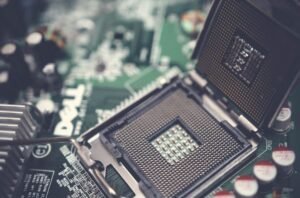Neuralink: What Can It Do?
Neuralink is a revolutionary technology company founded by Elon Musk that aims to merge the human brain with artificial intelligence (AI). This innovative venture has generated significant interest and excitement since its announcement in 2016. By developing high-bandwidth brain-machine interfaces (BMIs), Neuralink seeks to enhance human cognitive abilities and revolutionize the way we interact with technology.
Key Takeaways:
- Neuralink aims to merge the human brain with artificial intelligence through high-bandwidth brain-machine interfaces.
- The company seeks to enhance cognitive abilities and revolutionize human interaction with technology.
- Neuralink has the potential to treat neurological disorders and disabilities.
- Ethical concerns and risks surrounding the technology must be addressed.
Neuralink’s primary objective is to bridge the gap between humans and machines by creating a direct connection between the brain and computers. The company aims to develop efficient and safe brain-machine interfaces that enable bidirectional communication channeling information between the brain and external devices. This could unlock a range of possibilities, including augmenting human intelligence, restoring mobility to individuals with paralysis, and even providing a potential cure for certain neurological disorders and disabilities.
*The concept of seamlessly merging humans with artificial intelligence is at the core of Neuralink’s vision.*
One important aspect of Neuralink’s technology is its potential to amplify human cognition. By linking the brain directly to AI systems, individuals could potentially access vast knowledge bases, perform complex calculations effortlessly, and develop new skills at an accelerated pace. This would mark an unprecedented leap in human intelligence and revolutionize various industries, including education, healthcare, and research.
*Imagine gaining access to unlimited knowledge and instantly acquiring new skills through a simple brain-machine interface.*
The Potential of Neuralink
Neuralink’s potential extends beyond enhancing human cognitive abilities. The technology could significantly impact the lives of people with neurological disorders and disabilities. By connecting the brain with external devices, Neuralink may offer effective treatments for conditions such as Parkinson’s disease, Alzheimer’s disease, and spinal cord injuries. This could bring hope to millions of individuals worldwide and help restore lost functionalities.
*Neuralink could provide groundbreaking solutions for treating neurological disorders and enhancing quality of life.*
Addressing Ethical Concerns and Risks
While the potential benefits of Neuralink are vast, it is crucial to address the ethical concerns and risks associated with merging humans and AI. Privacy and data security issues arise concerning the access and storage of sensitive brain data. Ensuring the technology is accessible and affordable to all is another challenge to overcome. Moreover, establishing robust regulations and guidelines is necessary to prevent misuse or coerced use of Neuralink.
*Balancing technological advancements with ethics and safeguarding individuals’ rights is paramount.*
Tables
| Neuralink Application | Potential Benefits |
|---|---|
| Restoring mobility to paralyzed individuals | Improved quality of life, regained independence |
| Treating neurological disorders | Potential cure, symptom relief |
| Augmenting human intelligence | Enhanced cognitive abilities, accelerated learning |
Conclusion
Neuralink, spearheaded by Elon Musk, is a groundbreaking technology company that aims to merge human brains with AI through brain-machine interfaces. The potential of this technology is immense, from enhancing cognitive abilities to treating neurological disorders and disabilities. However, it is crucial to address ethical concerns and minimize risks to ensure a responsible and beneficial integration of humans with AI. Neuralink holds the promise of transforming our relationship with technology and unlocking unprecedented capabilities.

Common Misconceptions
Misconception 1: Neuralink can read people’s minds
One common misconception about Neuralink is that it can read people’s thoughts and extract information directly from their brains. However, this is not entirely true. Neuralink technology allows for the recording and decoding of brain activity, but it cannot access people’s thoughts or read their minds in the traditional sense.
- Neuralink records electrical signals from the brain.
- It analyzes this data to understand patterns and correlations.
- It is primarily focused on restoring motor functions and treating neurological disorders.
Misconception 2: Neuralink can enhance intelligence
Another misconception is that Neuralink can be used to enhance intelligence or make someone smarter. While Neuralink has the potential to improve brain-computer interfaces, it does not directly boost intelligence or enhance cognitive abilities beyond an individual’s natural capabilities.
- Neuralink is designed to address neurological issues, not enhance intelligence.
- It aims to restore function to the brain, such as allowing movement in paralyzed individuals.
- It may enable humans to keep pace with AI by enhancing computational capabilities.
Misconception 3: Neuralink is only for healthy individuals
Many people assume that Neuralink is only intended for healthy individuals who want to upgrade their brains. However, the main focus of Neuralink is to provide treatment options for individuals with neurological disorders or injuries.
- Neuralink seeks to help people with conditions like paralysis or epilepsy.
- It aims to restore lost functions and provide a better quality of life for patients.
- It may also enable deep brain stimulation for psychiatric disorders.
Misconception 4: Neuralink poses a threat to privacy
There is a misconception that Neuralink poses a significant threat to personal privacy. While it is true that the technology involves accessing and recording brain activity, Neuralink’s primary goal is to benefit individuals and improve human life, rather than invade privacy.
- Neuralink is being developed with strict ethical considerations in mind.
- Privacy concerns are taken seriously, and efforts are made to ensure data security.
- Access to neural activity is carefully controlled and managed by the individual.
Misconception 5: Neuralink is ready for widespread adoption
Some people believe that Neuralink is already ready for widespread adoption and use by the general public. However, it is still in the early stages of development and testing, with the current focus on clinical trials and treating specific medical conditions.
- Neuralink is currently being tested in animals to ensure its safety and effectiveness.
- The technology has not yet received regulatory approval for broad commercial use.
- Further research and development are needed before Neuralink can become widely accessible.

Table: Neuralink: A Breakthrough in Brain-Computer Interfaces
Neuralink, a company founded by Elon Musk, is pioneering the field of brain-computer interfaces (BCIs) with the aim of revolutionizing the way we interact with technology. BCIs offer the potential to overcome physical limitations, restore lost sensory functions, and even enhance natural abilities. This table showcases some of the remarkable capabilities and applications of Neuralink.
Table: Neuralink’s Brain Implant – The Link
The Link, Neuralink’s brain implant, is a key component of its BCI system. This table highlights the main features and specifications of this groundbreaking device, which is designed to interface seamlessly with the human brain.
Table: Enhanced Cognitive Abilities with Neuralink
Neuralink’s BCI technology has the potential to augment our cognitive abilities in remarkable ways. This table showcases some of the extraordinary improvements that could be achieved using Neuralink implants, from memory enhancement to accelerated learning.
Table: Overcoming Physical Disabilities with Neuralink
For individuals with physical disabilities, Neuralink offers hope for a more independent and fulfilling life. This table illustrates how Neuralink’s BCIs could assist in restoring lost motor function and improving quality of life.
Table: Sensory Restoration with Neuralink
Neuralink aims to enable individuals with sensory impairments to regain their ability to see, hear, and touch. This table demonstrates the potential of Neuralink in restoring sensory experiences and breaking barriers for those with visual or auditory deficits.
Table: Real-Time Brain-Machine Interfaces with Neuralink
Neuralink’s ability to create real-time interfaces between the brain and machines is truly remarkable. Explore this table to see how Neuralink could revolutionize the way we control electronic devices, prosthetics, and even vehicles.
Table: Advances in Mental Health Treatment with Neuralink
Mental health conditions can have a profound impact on life quality. This table highlights how Neuralink’s BCIs could contribute to more effective treatments for disorders such as depression, anxiety, and PTSD.
Table: Ethical Considerations of Neuralink Technology
Innovations like Neuralink raise important ethical considerations. This table examines some of the key ethical questions surrounding brain-computer interfaces and discusses potential challenges and solutions.
Table: Neuralink’s Clinical Trials and Progress
Neuralink has been conducting clinical trials to test the safety and efficacy of its BCI technology. Take a look at this table to learn more about Neuralink’s progress and the potential timeline for widespread adoption.
Table: Potential Future Applications of Neuralink
Neuralink’s technology holds immense potential for future applications beyond what we can currently envision. This table provides a glimpse into some speculative but exciting possibilities, from telepathic communication to immersive virtual reality experiences.
In conclusion, Neuralink’s groundbreaking brain-computer interface technology offers immense potential to transform our lives. It has the ability to restore lost functions, enhance cognitive abilities, and open new frontiers in human-machine interaction. As research and development continue, we eagerly await the moment when Neuralink’s advancements become accessible to a broader audience, enriching our lives and pushing the boundaries of human potential.
Frequently Asked Questions
What is Neuralink and what does it do?
How does Neuralink work?
What are the potential applications of Neuralink?
Is Neuralink safe?
What are the challenges and limitations of Neuralink?
Are there any ethical concerns associated with Neuralink?
Will Neuralink replace human capabilities?
Is Neuralink available to the public?
Can Neuralink interface with other devices?
How long does it take to see the effects of Neuralink?




